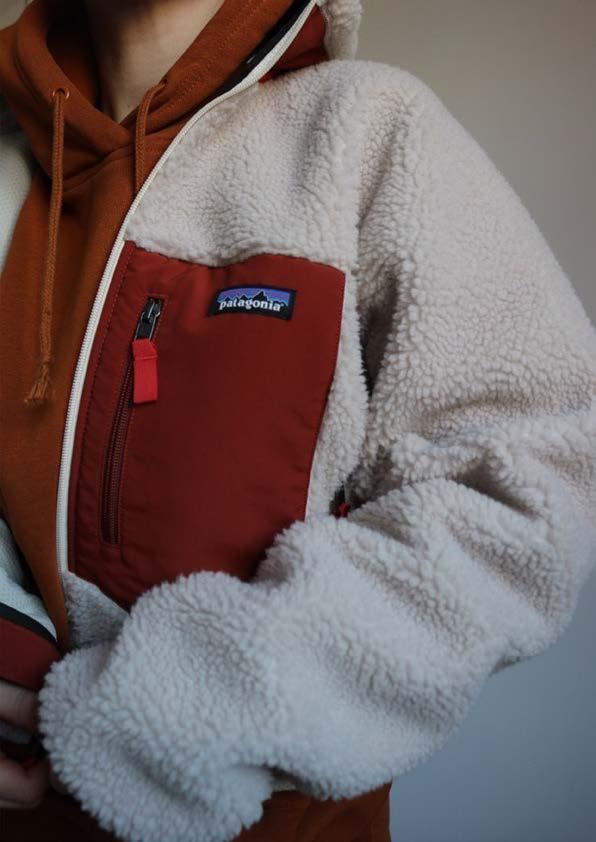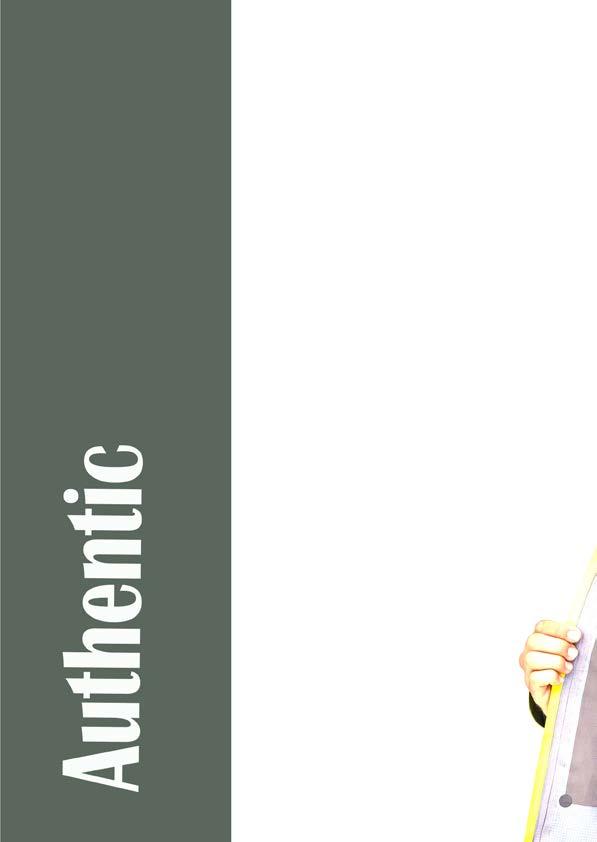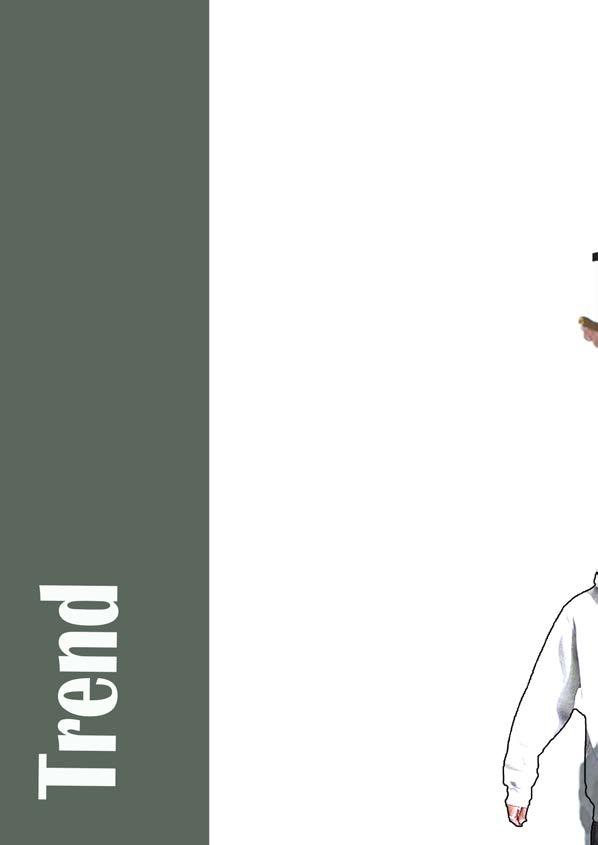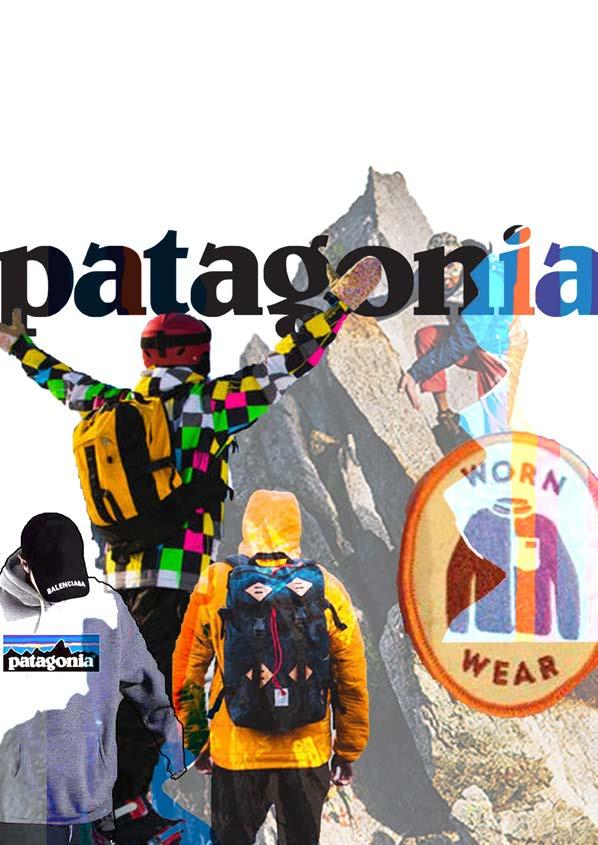
13 minute read
Patagonia
Background knowledge:
Patagonia is a United States label founded in 1973 by Yvon Chouinard. Since the young age of 14, Yvon Chouinard found a passion and spark for a lifelong love of rock climbing (he took lessons in Southern California). Before Yvon knew it, he came into business by producing the gear he needed to face the mountains, the word spread and soon he was selling these products to fellow climbers. Despite profits slim and selling gear out the boot of his car, by 1970 Chouinard equipment had become the largest supplier of climbing hardware in the United States. With the company growing, himself and his partner Frost began to see clothing as a way to support the marginally profitable hardware business, and the rest his history… Originating from Monte Fitz Roy in Southern Patagonia (one of the world’s toughest mountains to climb), Patagonia took this name to resemble their products ability to withstand even the hardest environments. What products do Patagonia offer?
Advertisement
Patagonia offer a diverse product line of outdoor clothing and gear marketed as sustainable. Ranging from a variety of sports including skiing, snowboarding, climbing, hiking, trail running and many others, there products cover both men and women. Their outerwear products can be seen to come in a variety of colours, most known for their bright, vibrant array of yellow’s, red’s, purple’s, green’s and blue’s, they are certainly recognisable for their choice of colour. I think the reasoning behind this is that they want to resemble their products with the sunrise peering over the Monte Fit Roy mountain (as seen in their logo) to further make the link between the two. The products are minimalistic with their items being block colours with branding noticeable on most if not all products. Materials and designs alternate throughout the product line depending on which climate and sport the garment is designed for. Patagonia have participated in a shy number of collaborations; however, they did partner up with the well-established brand Danner to create a high quality, lifelong fishing boot. This brand has similar qualities to Patagonia, therefore applied to their already habitual audience. Patagonia can be in the luxury market due to their costly price point and high quality, durable items.

Where can you find Patagonia?
Despite originating from the US, Patagonia has become a worldwide retailer. Alongside physical stores around the globe, Patagonia also trade through ecommerce, a platform which is significantly becoming the most popular way to shop.
Who is Patagonia’s competition?
Patagonia’s competition consists of other outwear and sporting retailers (The North Face and Columbia Sportwear Company are two to mention). Despite being in the same market I believe Patagonia are at a competitor advantage as they do not specialise in one sport alone, and instead they cater for a wider majority.
Also, Patagonia have established a different style of advertisement, they incorporate humour and environment conversation to create their bold, eye-catching advertisement. Across many accounts they hold on social media platforms they tally up to millions of followers, Patagonia use this space to inform their audience of key events, new product lines, the brand has been successful as communicating with its audience through this usage. 25
Who is the consumer?
The current consumer base for Patagonia consists of middle to young, aged individuals (those who fall into the categories between generation Z and X). It is reasonable to assume most of the consumers have a passion and interest for sport and the outdoors, however a percentage may be purchasing Patagonia products as casual/ streetwear attire. As Patagonia offers long lasting luxurious items, the consumer is willing to spend more on quality, rather than disposable throwaway garments. As a consumer base who think about the environment, they are passionate about decreasing the impact they make on the planet, they are open to purchasing second-hand garments.




Patagonia is in mission to save our home planet. Patagonia are seen in many ways to be tackling the issue on sustainability, and this has been evident since they started to devote time and money to the increasingly apparent environmental crisis when they were a start-up small business. Countless acts have been taken since, including becoming fair trade certified, a Certified B Corporation, launching Patagonia action works, using 100 percent organic and recyclable materials, plus many more to mention Yvon Chouinard (the founder) alongside Craig Matthews started a huge sustainability movement by creating 1% for the Planet. Patagonia give 1% of their sales back to the environment. Worn wear is Patagonia’s hub for keeping gear in play, the brand aims to extend the life of the gear for as long as possible by repairing, reselling and recycling. Here Patagonia are seen to be meeting one of their missions to inspire and implement solutions to the environmental crisis. The brand has been successful in persuading their audience to reduce consumerism by offering free repairs and second-hand clothing. Patagonia are strong believers that consumers need to think twice before they buy. Stated as ‘Better Than New’ their consumer is proud to own a worn wear item as it stands them out for their movement, a worn wear label is proudly attached. I believe that a worn wear item adds value to the product as it tells a story. Patagonia stands out by being one company which controversially asks their audience to buy less on black Friday. The company ran a poster and PR campaign telling consumers “Don’t buy this jacket”, this was intended to spread a sustainable message.

This buy less, more quality philosophy was placed in the most important national newspaper the Times. This advertisement is another example of how Patagonia have approached the matter of sustainability, they are attempting to re-shape the way their audience thinks, whilst establishing a strong sense of community as the brands values become more respected. All sales from the black Friday event were donated to environmental non-profits. As stated by Patagonia’s head of PR “there is no business” said Dean “if there is no planet”.

I believe that Patagonia is certainly representative, the brand can represent the wearers personality and lifestyle. Firstly, Patagonia can represent an individual of class. You can be expected to spend up to £800 on a Patagonia jacket, £300 for a pair of pants and £120 for a single T-shirt, wearing this brand therefore creates an illusion the wearer is wealthy with great disposable income coming in to spend, even if this is not the case. Patagonia further represents a person who wants to make a difference, somebody that is a conscious buyer. Whether the wearer has a great understanding of the current day sustainable issue or not, the consumer can be seen to be a part of the movement. Many may purchase from Patagonia because they resonate with the brands value and beliefs, I picture a person who has close correlation with a rural environment, spends most of their time submerged in nature and participating in outdoor sports regularly. However, despite this healthy active lifestyle pictured, a polar opposite case is likely.

Patagonia is individual in comparison to its competitors in the market. Patagonia has found a niche in focusing on anything outside related, in both men and women’s clothing and gear. Patagonia is one of few retailers that provide this, separating them for the likes of ‘The North face’ who specialise in mountains and ‘Columbia Sportwear Company’ who specialise in bodies of water. Although all outdoor clothing companies claim to be the best for an outdoor quest, I think that Patagonia have made a greater success noticing this gap in the market. As Patagonia have a high price point and fall into the luxury category, offering this variety will not only benefit them competitively but also financially.



Patagonia, I believe are materialistic, the brand’s products are heavily branded with a bold, unmissable logo imprinted across the chest or most commonly on the left shoulder. In a selection of products, the branding takes over the entire front of the garment making it easily identifiable to others. Alongside heavy branding on mainstream items, materialism can also be evident in Patagonia’s worn wear collection. On worn wear items a tag which states ‘worn wear’ is sewn on to ensure identification. Their target market may favour this branding for reasons being, the items come at a high price point, this creates an instant judgement that the wearer is wealthy and in a strong financial position to purchase outerwear products that come at a price. The consumer may also want to flaunt they participate in said sports and are acknowledged as a professional, or someone who is superior to an individual who participates in more accessible activities. Furthermore, people may want to wear Patagonia’s worn wear to resonate as someone who cares for the planet, they may be proud that they are a part of the movement and feel the need to make others aware they done a good deed for self-fulfilment.


“We knew it was the start of something good” as Danner stated, knowingly that Patagonia never truly collaborated prior on a product. Danner and Patagonia go hand in hand with experience and long histories in the outdoor space (Danner specialises in making rugged hiking boots). Patagonia have not chosen a brand at random; it has been carefully curated to find a company which strive for similar outcomes. This sensible match both wanted a product with durability, and therefore welcomed the two fly fishing boots, in which are comfortable, practical and durable. This partnership shows that Patagonia are not interested in exploring other areas in the market and producing something completely controversial to a new target audience and instead want to continue producing high quality products for their exciting loyal customers.


I think that Patagonia carry an unappealing aesthetic in their collections, through their use of colours and style fonts ‘Belwe Bold’ a daring look is created. A preponderance of pockets, zippers and pulls, far more than what be deemed necessary, located around the moody brown or bright pops of colour products can be viewed as overpowering and too much for the human eye. I think that Patagonia have certainly identified their own aesthetic, the brand is not trend driven and instead designs are made for practicality reasons rather than look. How beautiful the product looks are not a priority for this brand and is it the bottom of the list for their concerns. Despite the bright array of colours used, Patagonia I think have used this to ensure the wearer remains visible (even in the worst weather conditions) when in the mountains participating in their activity. As their aesthetic consists of block colours, the wearer is extremely distinctive and recognised for what brand they are wearing. I think this allows the wearer to easily identify with the tribe they are apart of. By being authentic, I think this is where Patagonia finds its fame. As stated by the director “We can’t control whether or not our brand is deemed cool or uncool, and we really don’t care”, I think the brand is rebellious.


Is Patagonia on trend for the current and future generation?
Patagonia’s current consumer base consists of middle to young aged individuals (A collation of Generation Z and X). Generation Z may end up saving the fashion industry, they understand the importance of sustainability (a key principle of Patagonia) and are willing to think outside the box when recycling clothing. Also following recent events (Covid-19) consumers are becoming more concious buyers. Patagonia is a retailer a person can contribute to fashion and feel as though theyre taking part in the movement due to their countless efforts on tackling the issue. Alongside Patagonia targetting this market, they are already prepaired and on trend for the upcoming generations. Generaltion Alpha, although currently too young to purchase, will eventually favour a brand like Patagonia as they have similar belifs and qualities. As this cohort are mad about priotising the planet, Patagonia would be a perfect match and likely to be favourtized in years to come.


How do Patagonia bring humour into their branding?
As Patagonia tackle the serious issue of sustainability (quite a dull boring subject to some), they attempt to engage their audience with an up beat humourous approach in their advertisement. Patagonia are known for using informal/ humourous images in their advertisement. Said images include a hiker substituting binoculars with two beer cans, a fisher with a rod in one hard and a can of beer in the other, and images with exaggerated facial expressions, often these images are alongside a catchphrase “get hooked”, “get wet”. I think that Patagonia have been daring whith this advertisement approach, however I feel it has created a friendly talking point, their audience through word of mouth are likely to discuss about the humourous, eye catching images (a great free promotional method). To ‘Build a movement’ more than just traditional advertisement needs to be done.

Despite the website offering selections for both genders, it is certainly acceptable and likely an individual will purchase an item from the opposite geneder’s category. Between the two there appears to be slim differentiation and an item is indetermined whether it is female or male. Designs, materials and colours are simultanious. Although Patagonia provides clothing for both sex’s, I think that it is most popular amongst men. I think that as the products are minimilisticly designed with a block colour, they therefore have a masculine presence about them. Due to the products having a masculine origin, the brand will drive in the male consumer. Furthermore, in many photography images, it is a male model. Although some capture a female, this is less likely.


Patagonia targets consumers globally which means they must provide consumers from all regions the opportunity to shop both in store and online. To ensure this is achieved Patagonia have opened independent stores around the globe. For those who can’t easily access a store, patagonia have e-commerce available. I believe this has benefited Patagonia’s success.










